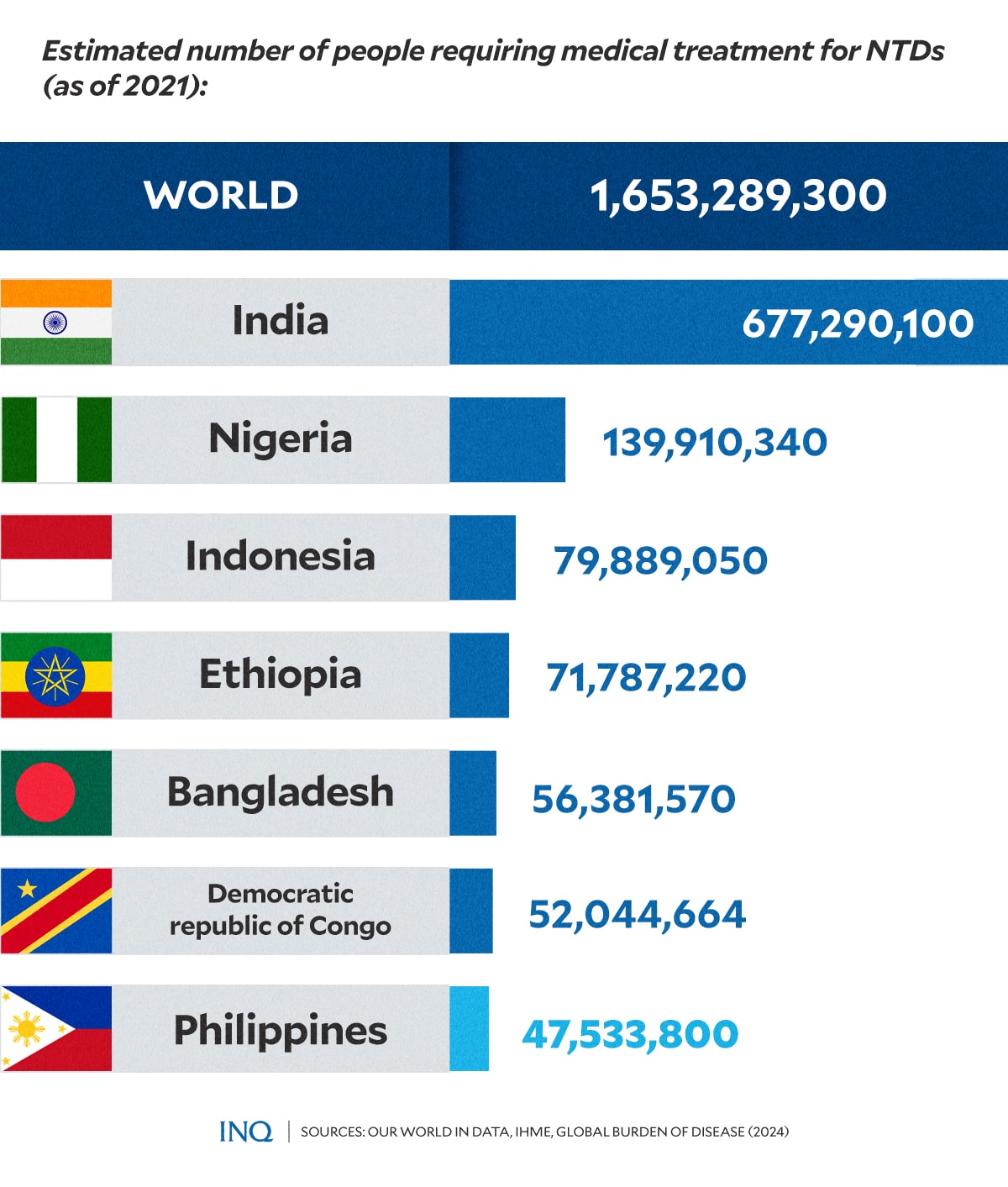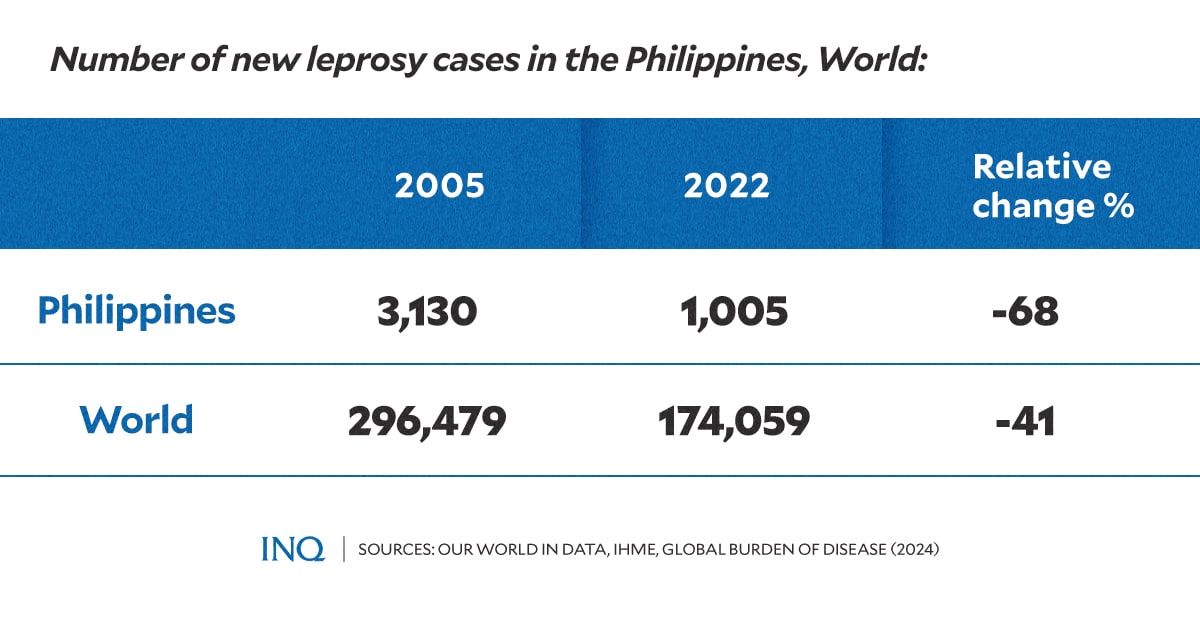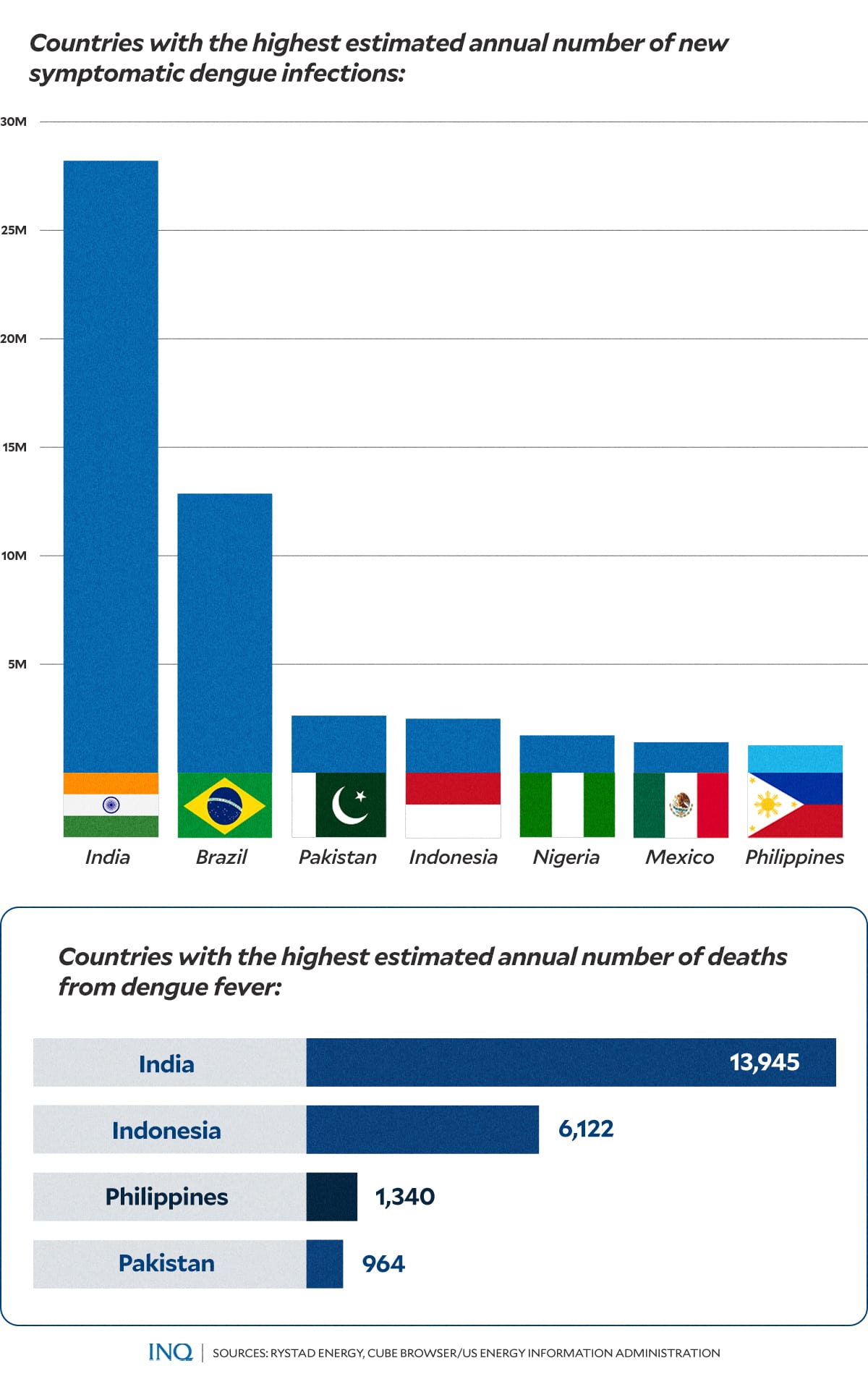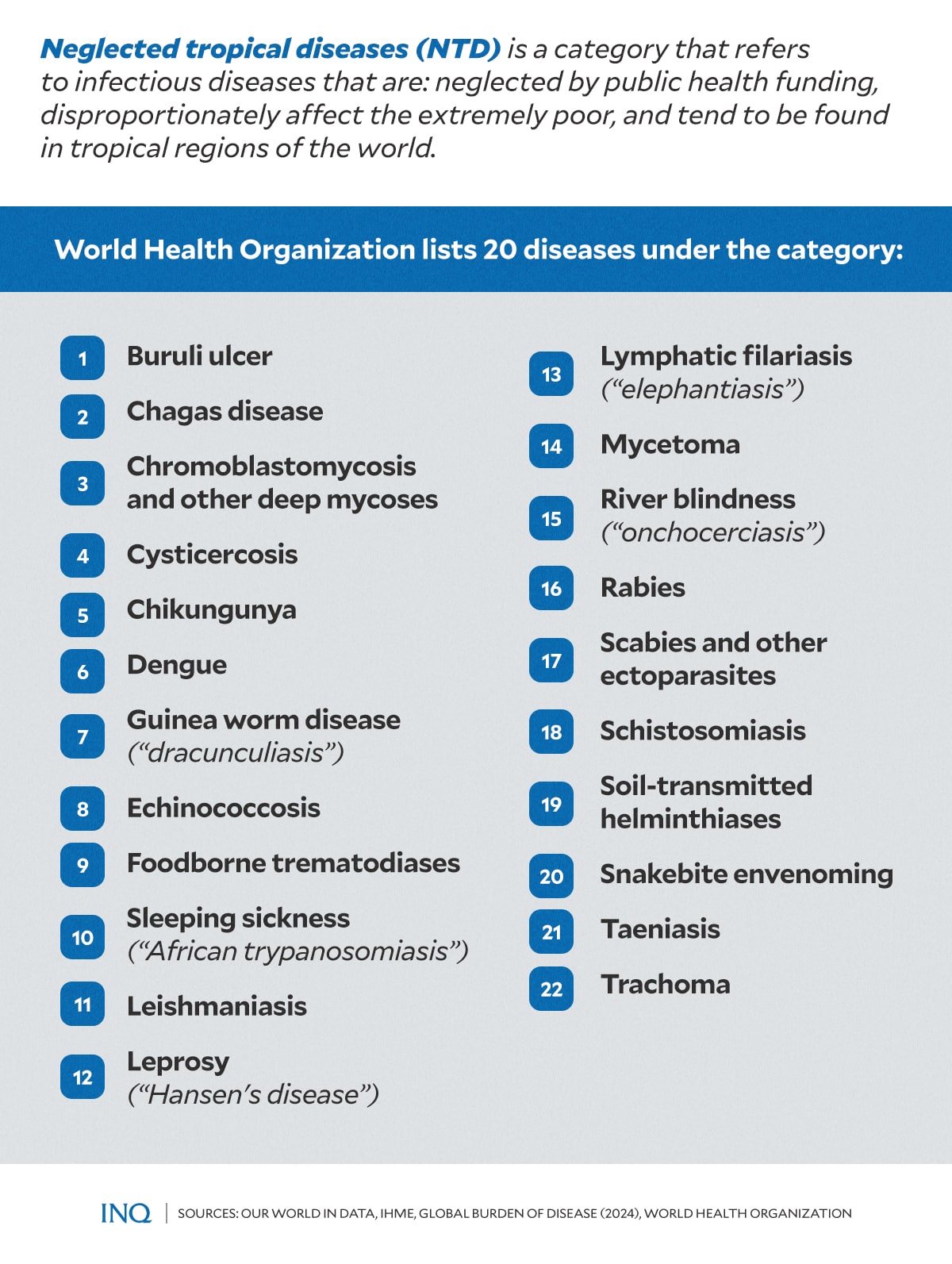PH ranks high in neglected tropical diseases: What to know
MANILA, Philippines—The Philippines is one of the countries with the highest number of people needing medical treatment for neglected tropical diseases (NTDs) — a diverse group of conditions that receive little public health funding, disproportionately affect the extremely poor, and are typically found in tropical regions.
NTDs, as defined by the World Health Organization (WHO), are caused by various pathogens, including viruses, bacteria, parasites, fungi, and toxins. These diseases lead to severe health, social, and economic impacts.
“The epidemiology of NTDs is complex and often related to environmental conditions,” WHO said.
“Many of them are vector-borne, have animal reservoirs and are associated with complex life cycles. All these factors make their public health control challenging,” it added.
WHO categorizes the following as NTDs:
Article continues after this advertisement- Buruli ulcer
- Chagas disease
- Chromoblastomycosis and other deep mycoses
- Cysticercosis
- Chikungunya
- Dengue
- Guinea worm disease (“dracunculiasis”)
- Echinococcosis
- Foodborne trematodiases
- Sleeping sickness (“African trypanosomiasis”)
- Leishmaniasis
- Leprosy (“Hansen’s disease”)
- Lymphatic filariasis (“elephantiasis”)
- Mycetoma
- River blindness (“onchocerciasis”)
- Rabies
- Scabies and other ectoparasites
- Schistosomiasis
- Soil-transmitted helminthiases
- Snakebite envenoming
- Taeniasis
- Trachoma
- Yaws
“They are ‘neglected’ because they are almost absent from the global health agenda,” WHO said.
Article continues after this advertisement“Even today, when the focus is on Universal Health Coverage, NTDs have very limited resources and are almost ignored by global funding agencies,” WHO explained.
NTDs primarily affect underserved populations, creating a cycle of low educational achievement and restricted job prospects. These diseases are also often linked to stigma and social exclusion.
Filipinos with NTDs
According to WHO data, over 1 billion people worldwide are estimated to be affected by NTDs. Additionally, 1.6 billion people require interventions for NTDs, both preventive and curative.
As of 2021, India had the highest number of people requiring medical treatment for NTDs, with 677 million individuals affected. This represents a 19 percent decrease from the 837 million recorded in 2010.
The Philippines ranked seventh globally, with 47.5 million people needing medical treatment for NTDs in 2021. This figure reflects a 10 percent decline from the 52.8 million recorded in 2010.
A 2019 study published on Acta Tropica, an international journal on infectious diseases, noted that there are 10 NTDs prevalent in the Philippines.
However, the study stressed that only six — lymphatic filariasis, schistosomiasis, soil-transmitted helminths, food-borne trematodes, rabies, and leprosy — are considered to be of public health importance.
The study authors highlighted that 81 provinces in the Philippines are endemic, meaning these diseases are regularly occurring within the area or community, for at least one of six neglected tropical diseases (NTDs), while some provinces are endemic for two or more of these diseases.
NTDs and blindness
Several neglected tropical diseases (NTDs) can cause permanent blindness if not treated. One such disease is trachoma, an infection caused by the bacterium Chlamydia trachomatis.
According to WHO, trachoma remains a public health issue in 42 countries and has led to blindness or visual impairment in about 1.9 million people.
Another major cause of blindness worldwide is river blindness, also known as onchocerciasis. This disease is caused by a parasitic worm spread through repeated bites from infected blackflies.
Symptoms of river blindness include severe itching, skin damage, and vision loss, which can lead to permanent blindness.
Data from Our World in Data showed that trachoma and river blindness are among the leading causes of blindness worldwide, alongside cataracts, glaucoma, refractive disorders, malaria, and age-related macular degeneration.
The data also revealed that there are no reported cases of blindness caused by trachoma or river blindness in the Philippines. However, cataracts are the leading cause of blindness among Filipinos, surpassing other common eye conditions.
Elephantiasis
Lymphatic filariasis, commonly known as elephantiasis, is one of the NTDs endemic to the Philippines. This condition is caused by microscopic parasitic worms.
According to the U.S. Centers for Disease Control and Prevention (CDC), lymphatic filariasis is transmitted through the bite of an infected mosquito. The most effective way to prevent the disease is by avoiding mosquito bites.
While some individuals infected with lymphatic filariasis may never exhibit symptoms, others may not experience any signs until several years after infection. For those who do develop symptoms, they may include:
- Lymphedema: Swelling of the legs, arms, breasts, or genitalia, with severe cases sometimes referred to as elephantiasis.
- Hydrocele: Swelling in the scrotal sac, typically affecting adult men.
- Hardening or thickening of the skin.
- Persistent coughing, wheezing, or shortness of breath.
- Bacterial infections of the skin or lymphatic system.
“These patients are not only physically disabled, but suffer mental, social and financial losses contributing to stigma and poverty,” WHO emphasized.
READ: Filariasis in PH: A neglected but discriminatory disease
According to Our World in Data, there were 975,293 recorded cases of lymphatic filariasis in the Philippines in 2021. By the following year, an estimated 4,149,619 people in the country were at risk of the disease and needed preventive chemotherapy.
Eliminating lymphatic filariasis is achievable by preventing the spread of the infection through preventive chemotherapy. However, in 2022, only 40.4 percent of those needing treatment for the disease in the Philippines received medical care.
In 2023, the Department of Health (DOH) reported that out of the 46 provinces in the Philippines where lymphatic filariasis is endemic, 44 have already been declared free of the infection.
The DOH noted that most of the recorded cases are concentrated in the Davao Region, Bicol Region, Palawan, Eastern Samar, Northern Samar, Caraga (Region 13), Surigao del Sur, Surigao del Norte, and Mimaropa (Region 4B).
PH dengue cases
Data showed that the Philippines is still among the countries with the highest estimated annual number of dengue fever cases and deaths.
In 2021, the Philippines reported approximately 1.26 million new symptomatic dengue infections, ranking seventh worldwide. This number is lower than countries such as India and Brazil, which reported 28.2 million and 12.9 million cases, but remains significant in the global context of dengue transmission.
The Philippines also ranks third in terms of dengue-related deaths, with 1,340 fatalities recorded in 2021. India reported the highest number of deaths at 13,945, followed by Indonesia with 6,122 deaths, while Pakistan reported 964 deaths.
WHO identifies dengue as one of the fastest-spreading mosquito-borne viral diseases in the world, with cases increasing dramatically in recent decades.
According to DOH, the country experiences a seasonal surge in dengue cases, especially during the rainy season, due to the increase in breeding sites for Aedes mosquitoes, which transmit the dengue virus.
Last month, heavy rains brought by the southwest monsoon (Habagat) and Super Typhoon Carina led to a surge in dengue cases across the country.
The health department said the country’s dengue cases stood at 136,161 from Jan. 1 to Aug. 3, which is 33 percent higher than the 102,374 cases recorded in the same period last year.
It also said that dengue-related deaths during the same period reached 364, lower than the 401 deaths logged in the same period last year.
Several local governments have already declared an outbreak or placed their areas under a state of calamity to address the growing health concern.
One of the affected areas was Ormoc City in Leyte, which was placed under a state of calamity in early August after experiencing a 225 percent increase in dengue cases from Jan. 1 to Aug. 3 compared to the same period last year.
READ: Ormoc City under calamity due to dengue outbreak
READ: Dengue spike puts Iloilo City under state of calamity
Earlier this week, the province of Bohol declared a province-wide dengue outbreak due to a significant rise in cases of the mosquito-borne disease, which have surged by over 450 percent since January.
According to data from the Bohol Provincial Health Office, dengue cases in the province from January 1 to August 24 reached 5,839 — an increase of 451.4 percent compared to the 971 cases reported during the same period last year.
READ: Dengue outbreak declared in Bohol
In light of the sharp increase in dengue cases nationwide, the DOH reiterated the importance of the “4S strategy” to combat dengue: “Search and Destroy” mosquito breeding sites, “Secure Self-Protection” from mosquito bites, “Seek Early Consultation” when symptoms appear, and “Say Yes to Fogging” in hotspot areas.
‘Ambitious’ plan
To address the country’s current problems related to NTDs, the DOH launched its Multi-Disease Elimination Plan (MDEP) on World Neglected Tropical Diseases (NTD) Day last January.
The MDEP aims for the Philippines to achieve zero or significantly reduced new infections of priority diseases by 2030 through a robust healthcare system.
Developed by the health department, with support from the USAID Act to End NTDs | East program and partners, the plan emphasizes integrating previously separate infectious disease programs into primary health care as part of a long-term strategy for universal health coverage.
“The Philippine Multi-Disease Elimination Plan is a first of its kind to integrate several select vaccine preventable and infectious diseases for elimination in one strategic plan, including NTDs, that provides guidance on priority activities for 2024-2030 until the SDG NTD goals are realized,” said Health Secretary Dr. Teodoro Herbosa.
According to the DOH, the three main objectives of the MDEP are:
- to eradicate polio;
- to halt the transmission of yaws, measles, rubella, malaria, leprosy, and rabies;
- to lower the number of new cases of lymphatic filariasis, schistosomiasis, mother-to-child transmission of HIV, syphilis, and hepatitis B, as well as maternal and neonatal tetanus, to levels below those considered a public health problem.





